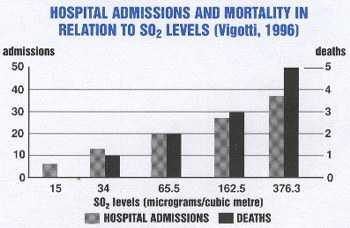Health Effects of SO2 and Sulphates
Sulphur dioxide (SO2) a primary air pollutant is generated when sulphur-containing fossil fuels or ores are burned. Much of this eventually turns into sulphate (SO4) in the atmosphere which is thus a secondary pollutant.
Ontario Sulphur Dioxide Emissions by Sector – 2012 Estimates
Smelters account for 62%, Transportation for 5%, Utilities for 4%, Miscellaneous/Residential for 3% and Other SO2 Industry Sources accounts for 26% of SO2 emissions in Ontario.
Health Effects
Sulphur dioxide and sulphates increase mortality.
Throughout the world, researchers have found that as sulphur dioxide and sulphate levels increase, mortality rates rise. Vigotti* and others (1996) compared air pollution data from four monitoring stations with death statistics in Milan. They found higher SO2 levels were related to an increase in the number of deaths. Studies in Helsinki, Athens and Beijing have found similar results. In a study of six US cities, Dockery* and others found sulphates were strongly associate with higher death rates due to lung cancer and cardiopulmonary disease. Sulphates and SO2 levels are both linked to increases in mortality. Although levels of these pollutants have decreased substantially, they continue to lead to early death throughout the world.
Sulphur Dioxide and Sulphates increase respiratory conditions such as asthma and bronchitis tend to increase during period of elevated sulphur dioxide or sulphates. A study in Paris by Dab* and others in 1996 measured SO2 levels and hospital admissions over a five year period. They found that admissions for all respiratory problems were related to SO2 levels. Similar research has been done on sulphates. While studying secondary pollutants in southern Ontario, Bates and Sizto* discovered that increased respiratory admissions to hospitals followed high sulphates days. Burnett* and others confirmed and extended this study. Sulphur dioxide and sulphates pose a significant risk to people with respiratory conditions.

People report more respiratory symptoms on higher sulphur dioxide and sulphate days. Symptoms such as coughing, wheezing and chest pain were associated with sulphates, as reported by Ostro* and others in 1993. Similar effects have been found with SO2. In addition, both sulphates and SO2 affect lung function. Pengelly* and others found that asthmatic children living in areas of higher SO2 displayed a decrease in lung capacity. Although SO2 and sulphate pollution do not seem to cause respiratory disease they do aggravate existing conditions.
SO2 and sulphates irritate your lungs, SO2 and sulphates can send you to the hospital and even kill you!
What is being done?
In 2016, the Canadian Council of Ministers of the environment announced new Canadian Ambient Air Quality Standards for sulphur dioxide. The new standards will contribute to improved air quality throughout Ontario and Canada.
For more information, click here.
What can you do?
REDUCE YOUR OWN EMISSIONS: Practice energy conservation and investigate emissions-free energy, such as solar power. Use public transportation, car pool, walk, rollerblade or cycle. If you do drive, keep your car well-maintained.
BE INFORMED: Request information from local government, the Ministry of the Environment , Environment Canada, plant managers and environmental groups.
BE INVOLVED: Start or join a citizens’ group. Write letters to the Minister of Environment and to your local MPP. Register complaints about air quality with the Ministry of Environment, Conservation and Parks online or at 1-866-663-8477.


